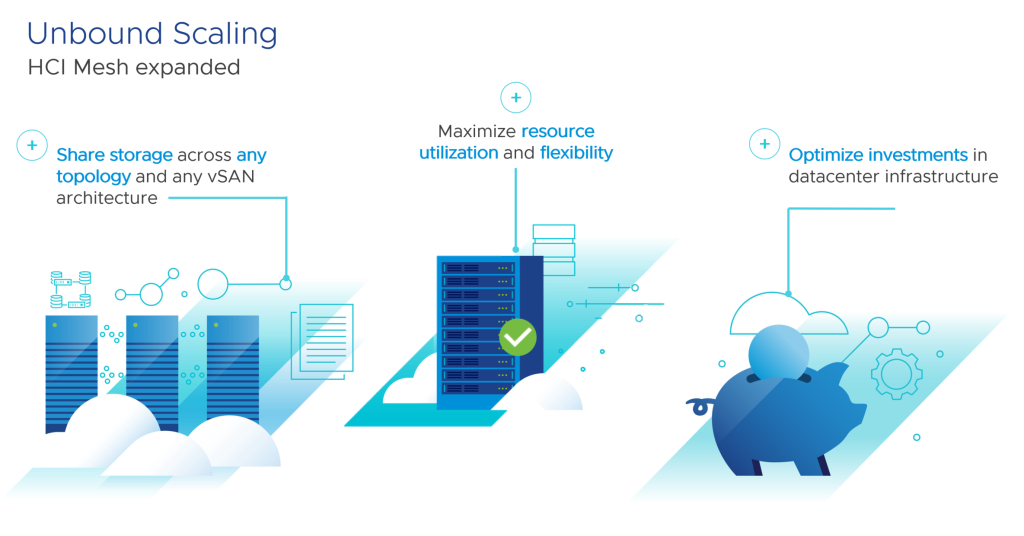
Recently, VMware announced the upcoming release of vSAN 8 Update 1. This latest update enhances vSAN’s capabilities and functionality with additional improvements for performance, data durability, and integration. Cloud Services Providers who are leveraging the capabilities of vSAN 8 can expect to see additional benefits in these areas as they deploy this upcoming release into their dedicated private cloud environments:
Expanded Reach of VMware HCI Mesh
 HCI Mesh Enhancements
HCI Mesh Enhancements
Supporting disaggregation of compute and storage resources is a critical component of Cloud Services Provider strategies to flexibly manage and optimize resources deployed for their tenants and to optimize ROI on hardware investments made for their customers. VMware HCI Mesh allows partners to share storage capacity across vSAN clusters and capture capacity that might otherwise have been stranded in clusters that run compute-heavy workloads, for example, and make it available for tenant workloads that need it elsewhere in the data center. Let’s take a look at some of the improvements specific to this area in this release:
- HCI Mesh will ensure no resources are left behind, by sharing storage across vSAN clusters. HCI Mesh can share storage across any topology, including stretched clusters and across vCenter servers. HCI Mesh will also allow partners to create storage-dense clusters that can provide storage for any vSphere-based workload.
- Previously limited to the original vSAN architecture, the power of HCI Mesh is now available on vSAN Express Storage Architecture (ESA), which was introduced in vSAN 8.0 last year.
- HCI Mesh support for stretched clusters on the original storage architecture (OSA) will be available with Update 1, improving capacity accessibility across vSAN stretched clusters.
- HCI Mesh support across vCenter servers will also be available in OSA with Update 1, enabling partners to allow their tenants to consume under-utilized resources between vCenter environments.
Core Platform Enhancements to vSAN Express Storage Architecture (ESA)
In addition to scaling Mesh use cases, vSAN has also made enhancements in the ESA architecture for performance in this update to support a wider landscape of workloads.
- Better Performance using New Adaptive Write Path: a new adaptive write path enables workloads issuing many writes, or highly sequential writes, to write the data in an alternate, optimized way. Improved streaming writes on ESA will offer up to 25% higher throughput and lower latency for sequential write workloads within vSAN Express Storage Architecture. This update will not only impact applications with a predominantly sequential write I/O profile, but we expect it will also expand the diversity of workloads that perform exceptionally well on vSAN ESA.
- Improved Performance for Discrete Workloads: To extract the most value from the higher performance of modern NVMe hardware, the latest vSAN update has optimized the I/O processing for each object residing on a vSAN ESA datastore, increasing the performance per VMDK by up to 25%. These performance improvements to single objects on ESA will be incredibly impactful on mission-critical VMs, including applications like relational databases and OLTP workloads.
- Enhanced Durability During Maintenance Mode Scenarios: With this update, ESA will gain the capability of RAID 5 and RAID 6 erasure coding for added protection against data loss during planned maintenance operations. This newly supported feature will ensure that data on ESA is stored redundantly in case of an unexpected host failure within a cluster while the host is in maintenance mode.
- Support for Cloud Native Storage (CNS) is now available for vSAN ESA. By using an existing vSphere environment to host DevOps Kubernetes workloads, partners are further increasing the value and ROI of the VMware virtualized platform. Partners can now help DevOps teams take advantage of the vSAN ESA performance for their DevOps environments to build out the next-generation cloud-native workloads
vSAN Storage Manageability Updates
 vSAN Manageability Updates
vSAN Manageability Updates
One of vSAN’s most notable characteristics is how it can significantly simplify storage operations and management. By utilizing Storage Policy Based Management or SPBM, partners and their tenants can define and apply storage capabilities using policies and apply them at a VM level. vSAN 8 Update 1 will offer several new improvements that simplify the day-to-day operations of administrators, as well as introduce a few new enhancements to help resolve issues more quickly.
- Auto-Policy Management for Default Storage Policies in ESA): vSAN ESA 8 Update 1 introduces a new, optional cluster-specific default storage policy that will help administrators run their ESA clusters with optimal resilience and efficiency. A new configurable “Auto-Policy Management” toggle will be available in the configuration at the cluster level. When this cluster feature is enabled, it will create and assign an efficient default storage policy based on the size and type of cluster.
- Higher Levels of Detail for Improved Performance Analysis: Available in both the Express Storage Architecture and Original Storage Architecture, the vSAN 8 Update 1 Performance Service now includes a “real-time” monitoring of performance metrics that collects and renders performance metrics at just a 30-second sampling interval.
- Capture Performance Diagnostics Information More Easily: In vSAN 8 Update 1, the VM I/O Trip Analyzer includes a new scheduler mechanism. Diagnostics can be run programmatically, allowing for more & better data collection, which can be critical to capturing temporary performance issues. This enhancement will be ideal for environments where a VM has a repeated, albeit brief, performance issue.
- Skyline Health Score and Remediation: The vSAN Skyline module UX is redesigned to include a new health dashboard, giving administrators a simplified view of the health status of each cluster. This visual status enhancement can help reduce the mean time to resolution (MTTR) and expedite troubleshooting efforts.
- vSAN Data Persistence platform (DPp) support of common vSwitches: vSAN 8 Update 1 lowers the barrier of cost and complexity by now making our DPp solutions compatible with the VMware vSphere Distributed Switch. Partners running dedicated clouds will need only vSphere+/vSAN+ licenses to use the Data Persistence Platform—on either vSAN OSA or ESA— and run stateful applications with lower TCO and simplified operations.
- Datastore management improvements: vSAN 8 Update 1 allows administrators to customize the size of namespace objects, enabling administrators to store ISO files and VMware content libraries more easily.
- New PowerCLI Integration: With vSAN 8 Update 1, PowerCLI supports many new capabilities in both the vSAN ESA and OSA architectures. With this integration, ESA users will gain easy access to their inventory to monitor and automate the management of their environment and resource provisioning.
- Thick provisioning for vSAN Direct Configuration: Using vSAN’s cluster configuration custom tailored for Cloud Native workloads, persistent volumes can now be programmatically provisioned as “thick” by the developer by defining it in the storage class.
Additional Resources
Use the following links to learn more about vSAN 8 update 1:
Additionally, join us by following the blog directly using the RSS feed, on Facebook, LinkedIn, and on Twitter, and by visiting our YouTube channel.
Originally posted on March 24, 2023 @ 6:04 pm


